#algorist
Explore tagged Tumblr posts
Text
Algorism is the technique of performing basic arithmetic by writing numbers in place value form and applying a set of memorized rules and facts to the digits. One who practices algorism is known as an algorist. This positional notation system has largely superseded earlier calculation systems that used a different set of symbols for each numerical magnitude, such as Roman numerals, and in some cases required a device such as an abacus.
0 notes
Text
Breaking Boundaries: The New Wave of Inclusive Digital Campaigns

Breaking Boundaries: The New Wave of Inclusive Digital Campaigns
In the ever-evolving landscape of digital marketing, the quest for innovation has birthed a new wave – one that is defined by inclusivity, connectivity, and cultural intelligence. As brands recognize the diversity of their audience, the paradigm is shifting towards embracing and celebrating differences through inclusive digital campaigns. This article explores the essence of this transformative trend, unravelling how forward-thinking digital marketing companies are breaking boundaries to resonate with a broader and more diverse audience.
The Rise of Inclusive Digital Campaigns
In recent years, there has been a notable shift in the way brands approach their digital marketing strategies. Rather than employing generic, one-size-fits-all campaigns, businesses are increasingly recognizing the importance of inclusivity. This shift is fueled by a desire to connect authentically with diverse consumer bases, understanding that a more inclusive approach not only fosters brand loyalty but also broadens market reach.
Digital Marketing Company Innovations
Leading the charge in this revolution are digital marketing companies that leverage cutting-edge technologies and strategies to create inclusive campaigns. These companies understand that digital intelligence is key to unlocking the potential of inclusive marketing. Through advanced analytics and consumer insights, they decode the diverse preferences, behaviours, and cultural nuances of their target audience.
One notable player in this arena is Algorist Global, a digital marketing company at the forefront of transformative campaigns. Algorist Global has embraced the power of digital intelligence to tailor campaigns that resonate with audiences on a personal level. By leveraging data-driven insights, they break down barriers and create content that speaks directly to the hearts and minds of diverse consumers.
The Impact of Brand Advertisements
In this era of inclusive digital campaigns, brand advertisements play a pivotal role. Brands are moving beyond traditional stereotypes and embracing a more authentic portrayal of diversity. Inclusive advertisements not only showcase the richness of different cultures but also contribute to a sense of belonging for consumers from various backgrounds. This shift is not just about checking boxes; it's about creating meaningful connections that go beyond transactional relationships.
Digital marketing companies are recognizing the need for authenticity in brand advertisements. Through careful curation of content and visuals, they ensure that campaigns reflect the true essence of diverse communities. This authenticity resonates with consumers, fostering a positive brand image and building trust.
Navigating the Digital Marketing Landscape
Breaking boundaries in digital marketing requires a deep understanding of the diverse digital landscape. This involves acknowledging the different channels, platforms, and mediums through which consumers engage with content. From social media and influencers to personalised email campaigns, digital marketing companies are navigating this intricate landscape to ensure that inclusive messages reach audiences where they are most active.
Conclusion
In conclusion, the new wave of inclusive digital campaigns is breaking boundaries and redefining the digital marketing landscape. Digital marketing companies, exemplified by industry leaders like Algorist Global, are embracing digital intelligence to craft campaigns that resonate with diverse audiences. Brand advertisements, infused with authenticity and cultural sensitivity, play a crucial role in connecting with consumers on a deeper level. As we navigate this transformative era, the impact of inclusive digital campaigns goes beyond marketing metrics – it shapes a cultural narrative that celebrates diversity, fosters inclusivity, and builds lasting connections between brands and consumers.
0 notes
Photo

OPHACO Sign of the Algorist
OPH(I)* = Peridot Sign • *ACO = Prospit + Greed
◈≫༻──◇──◇──༺≪◈≫༻──◇──◇──༺≪◈
#760: A sign for those who stick to the program and don't take well to glitches in their systems. Exact and precise, they're prone to get over-heated when confronted with unfamiliar syntax.
◈≫༻──◇──◇──༺≪◈≫༻──◇──◇──༺≪◈
Peridot Signs • Greedbound Signs • Prospit Signs
#TTSEZ#Peridot Caste Signs#Signs of Greed#Prospit Signs#SYM: Asymmetric#SMPL: Two#Style: Right Angle#Style: Tilde
1 note
·
View note
Text
Noise Field - TouchDesigner
12 notes
·
View notes
Text
i swear this proof i’m writing for an obscure little math trick in the Treviso Arithmetic is actual research for an actual fic and is of actual importance
(this is why i never finish writing anything, huh)
#HEY ANYONE WANNA TALK ABOUT THE ALGORISTS VS ABACISTS FEUD OF THE EARLY 1500s#I LOVE MATH HISTORY SO MUCH Y'ALL
4 notes
·
View notes
Text
"Ποίοι είναι οι αλγοριθμιστές (algorists)"
O Roman Verostko απαντά στην ερώτηση:
Με απλά λόγια ο Verostko αναφέρει οτι αλγοριθμιστές είναι οποιοιδήποτε δουλεύουν με αλγόριθμους, είναι επίσης και οι καλλιτέχνες που η τέχνη τους είναι προϊόν αλγοριθμικής διαδικασίας, ενός αλγόριθμου που οι ίδιοι δημιούργησαν.
Ιστορικά οι αλγοριθμιστές ταυτίζονται και ως μαθηματικοί. Πιο συγκεκριμένα η ιστορία της αλγοριθμικής τέχνης φτάνει πίσω στην προιστορικ’η τέχνη. Βέβαια όπως αναφέρει ο ίδιος με τις δυνατότητες του υπολογιστή εμφανίστηκε μια νέα καλλιτεχνική πρακτική η οποία ήταν μοναδική για το τελευταίο τέταρτο του 20ου αιώνα. Η δύναμη του υπολογιστή έδωσε στους αλγόριθμους του καλλιτέχνη μια κινητήρια δύναμη που θα μπορούσαμε να συγκρίνουμε με την δύναμη του κινητήρα στην βιομηχανική επανάσταση.
Η πρώτη επαφή του Verostko με την αλγοριθμική τέχνη ήταν το 1969 όπου θέλησε να μάθει πως να χρησιμοποιεί έναν αλγόριθμο ως καλλιτέχνης, την εποχή αυτή γνώρισε και άλλους καλλιτέχνες, ένας από αυτούς ήταν ο Jean Pierre Hebert, ο οποίος πρότεινε να υιοθετήσουν τον όρο “algorithm” και έγραψε το βιβλίο “the algorithm for an algorist” το οποίο αποτέλεσε κάτι σαν μανιφέστο.

Left to Right: Mark Wilson, Manfred Mohr, Roman Verostko & Frieder Nake Via:http://www.verostko.com/algorist.html
1 note
·
View note
Photo

Coder le Monde @centre pompidou paris Othoniel, Morellet and many other computer artists #coding #computer #computerart #algoristes #othoniel #morellet #charlescsuri #friedernake #herbertfranke #centrepompidou #weloveart (à Centre Pompidou)
#coding#computer#computerart#algoristes#othoniel#morellet#charlescsuri#friedernake#herbertfranke#centrepompidou#weloveart
1 note
·
View note
Photo

ALGORISTE
2 notes
·
View notes
Text
Welcome to Brilliance Gallery
Welcome to Brilliance Gallery, the only place online where you can acquire the Neo-Impressionist, abstract artwork offered by acclaimed Algorithmic Artist and Innovator, Peter McClard. Peter is an industry-leading algorist and his wall art often defies description but two words will come to mind when you see it and those are: beautiful and original. His artist-certified works are guaranteed to be a highly prized addition to your collection (or a friend's or loved one's as a very special gift). Each original art piece is comprised of thousands of fine details, amazing color palettes and is created using a proprietary process that only Peter fully understands. Peter’s mission is to make his art affordable and Brilliance Gallery is dedicated to providing you with the highest quality service and Museum Quality art you will enjoy living with for years to come. The art may be purchased as original works, limited editions, and as fine art prints on a variety of mediums including canvas, acrylic, paper, posters, or metal.
Please support this amazing artist and spread the word! Peruse current gallery collections below and check back occasionally as works come and go. Don’t miss out on your opportunity to buy one of these extraordinary works at special online prices.
Also, please follow us on Instagram #brilliance_galleries, @Brilliance_Galleries for hundreds of additional works. Let us know if you see something you like in this vast collection and we'll make it available here at BrillianceGallery.com!
Artist and innovator Peter McClard is a pioneer in the field of algorithmic art, i.e. art that is meta-generated with special original software through the use of artist-controlled algorithms. With a rare combination of artistic and mathematical prowess, Peter was among the very first artists to explore this new medium starting in the 1980s and remains, unquestionably, one of the best and most recognizable. His art is impossible to imitate by others and often leaves art experts scratching their heads as to how exactly he does it, which is a closely guarded secret.
Many of Peter’s works are based on photographs, art, or illustrations of people, animals, or objects, though he often draws or composes original abstract subjects for his process. A simple subject is his favorite because it allows the complex textures, colors, and forms of his art to heighten the beauty found in a simple thing and vice versa. As with many of the works on this site, Peter often works with iconic imagery of historical figures or images. Once he settles on a subject he will explore many variations using his unique process, often producing a closely related, yet astonishingly varied set of art (inquire about acquiring a highly valued full set). Also, he has been known to combine high-resolution photographic images with meta-generated art such as his spectacular Hubbleangelo series.
Because of the mathematical foundation of his work, Peter’s art has an eternal aspect (math never decays) and the powerful ability to scale to any size imaginable with no loss of quality because everything is described as a mathematical formula instead of “pixels”. These complex Master Files are then stored securely in an Escrow account from which a final rendering can be made to any specification. Inquire about obtaining rights to a Master File.
This artwork is protected by International Copyright laws and is sold with copyright restrictions that disallow reselling of the files themselves in any form or the commercial use in reselling more than one print or any form of mass production without prior written consent from Werlin Design Group, LLC / dba BrillianceGallery.com
For more details on our products and services, please feel free to visit us at: Low Cost Art, Mathematical Art, Michael McClard, Mural Art, Original Vector Art.
0 notes
Photo

Part 1: Last Friday Linn Heidi Stokkedal went to the Pre-histories and the Futures of Machine Vision symposium as the Victoria and Albert Museum. The symposium explored early moment in the development of computer art and machine vision, from the mid-1960`s onwards. Artist, designers and curators discussed aesthetic and political impact that contemporary computer vision and machine vision technologies have today. The symposium was divided into two sessions. The morning session looked towards the past, and early computer vision and art. The afternoon session was with practicing artists and what they are currently working on and looking into.

The first speaker was Douglas Dodds: Vision and Accident: Creating the V&A`s Computational Art Collection. He is a senior curator in the V&A Word and Image Department and is also responsible for developing the digital art collections. His talk was fascinating, showing a wide overview from the beginnings of computer art and up until now. He has curated exhibitions including Chance and Control: Art in the Age of Computers (2018); Barbara Nessim: An Artful Life (2013); and Digital Pioneers (2009-2010). He spoke about a movement called the Algorists, that I have never heard of before. Which is anyone who works with algorithms. Traditionally this has been applied to mathematicians but now also artists. Read more about the movement and the artists behind it here.

To find digital artworks from their collection, go to: collections.vam.ac.uk.
The next speaker was Zabet Patterson: A Portrait by a Computer as a Young Artist. She is an Associate Professor at Stony Brook University and wrote Peripheral Vision: Bell Labs, the S-C 4020, and the Origins of Computer Art, published in 2015. She presented a close-reading of some computer images even before the the first computer art became an art gallery item. The images she presented is from a contest from the trade journal Computers and Automation in 1963 and 1964.

She argues that the images chosen by this journal as “computer art” is “suggesting new relationships - and new regimes - of perception and knowledge. These images also show different attempts to reinvent and reconceive vision as adjunct to the computational machine (extracted from symposium handout). She was referring this images as as an older mode of aesthetics using the ancient greek term: aisthesis: meaning sensation or perception (see senses), in contrast to intellectual concepts or rational knowledge. The images are a another way of making sense and suggesting new perceptions.

This image of a bullet projectile visualization is set up like a Muybridge shoot, with mutiple cameras capturing several parts of the movement. The image was made to be informative and to become a training set for humans. A tool made by machine, for human visions. This next image below is from a project called Celestial Telescope (SCO) and shows UV wavelengths of brightness of stars. Zabet claims that this image if Unheimlich (aka. uncanny) and claims is a image made by machine for the machines.

She explains also what separates these visuals from more modern computer images, is that these are made and produced by giant machine that are very expensive (always based in a military or a government institution). Another point is that the images are also not made by artists, but engineers, which is typical for the beginning of computer art.
The next presenter was Joel McKim: Cybernetic Visions: Early Experiements in Ai by UK Computer Artists. He is a Senior Lecturer in Digital Media and Culture and the Director of the Vasari Research Centre for Art and Technology at Birckberck, University of London. He wanted to talk about 3 different people who had an impact on early machine vision. He started his presentation by introducing David Marr, a neurophysiologists who published “Vision” in 1982. He argued that vision is an information processing system.



It was interesting to see how Marr had made a overview of the processing steps from input and into 3D. Which can be compared to Deep Neural Network processing that we know today.


I found this talk very fascinating because this made the connection between the human vision processing system and how remarkably similar it is to the machines vision.
The second person that McKim introduces is Edward Ihnatowicz, a polish cybernetic art sculptor, producing works especially in the 60s. The first sculpture he built is called SAM (Sound Activated Mobile) which had built in microphones, which made it respond to surrounding sounds. The robot was constructed looking like a flower, and them stem looked similar to a vertebrae that moved towards the origin of the sound being made. Ihnatowicz most significant work is The Senster, a large hydralic robot that responded to both sound and movement. It is the first robot to be controlled by a computer.

and as the last example McKim presents Harold Cohen. An artist that worked a long a robot called AARON for most of his career. Cohen`s art practice was inspired by reading audiences and learn about meaning and how it is being made. He wanted to understand what creativity was and where it came from. He worked with his robot AARON in performative acts for a while (such as Turtle in 1977), before moving away from the spotlight and into the studio. AARON was trained to see foliage and people (representational imagery) and the robot was strictly rule-based. Cohen says that AARON`s art appeared meaningful, but was more “stand-in-forness”. Cohen never meant that he was working with computer art, but in stead it was painting dealing with images about perception.

That concludes the morning session. Afternoon session summary you will find in the next post.
Written by Linn Heidi Stokkedal 02.03.2020
1 note
·
View note
Text
Fall 2017: Week 2
by ann
Week 2 of the fall semester marked the first full week of classes for SFPC. Energized after the weekend, students came ready to debate singularities, jump into soldering and coding, and introduce themselves and their work to the community.
Day 1: Vera Molnár and The Algorists
Day 1 started with a class on media art with Zach Lieberman.
First, students shared the programming languages they had created as part of last week’s homework. Some highlights were a language called ‘pretty please’ that requires programmers to ask the computer nicely in order to get operations to execute, and a physical object interpreter for cooking.
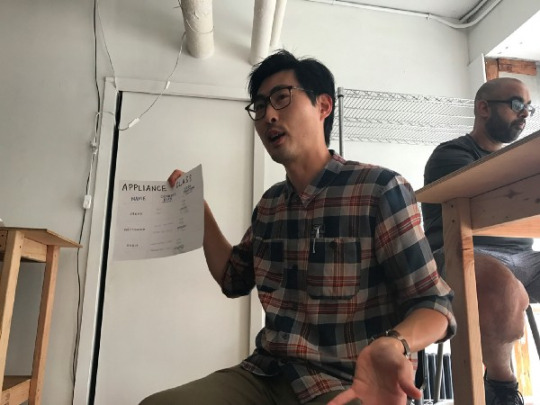
Next up was a lecture on the Algorists, and a group research session on the work and life of Vera Molnár, a pioneer of computer art.
Starting in 1959, Molnár created paintings using what she called the “Imaginary Machine.” Molnár would follow a series of set instructions with slight variations to create paintings that explored “the subtleties that turn a collection of forms into the ‘epiphany’ of art.” In 1968, she began working with a computer and plotter to expand her examination of algorithmic art.
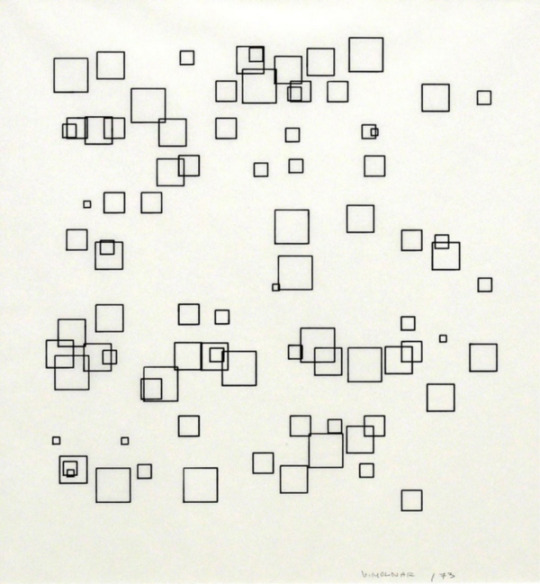
“This may sound paradoxical, but the machine, which is thought to be cold and inhuman, can help to realize what is most subjective, unattainable, and profound in a human being.” — Vera Molnar
Day 2: Political objects, Silicon Valley, and Women in Computing
Morehshin Allahyari’s class, The Radical Outside, began with a discussion of the week’s reading. Students debated if creators with biases and beliefs about the purpose and audience of the technologies they are making can intentionally or unintentionally bias the objects they create. Students talked about snapchat filters and automatic soap dispensers as examples of technologies that perpetuate the biases and skin tones of their developers. There was also a lively debate over whether certain technologies necessitated particular political systems, as argued in the article, Do Artifacts Have Politics?
“Who is we? Who gets to decide to create technologies?” — Morehshin Allahyari
Next, two students, Amit Runchal and Matt Ortega, presented their research on Silicon Valley ideology and women in computing, respectively.
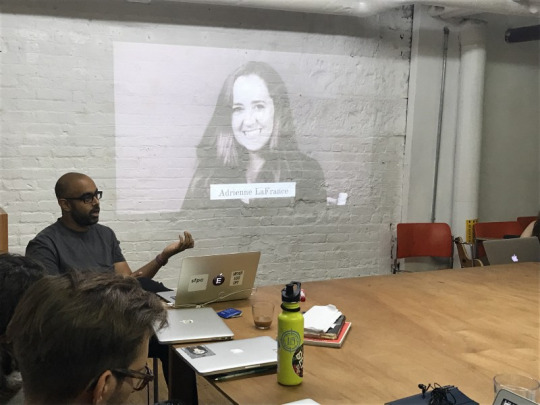
Amit argued that, “The suggestion that we should expect new technologies to reduce the gaps between the haves and have-nots” is too simplistic, and posited that the current technological revolution “will give birth to new forms of political philosophies” as it exposes the limitations in previous philosophies, such as capitalism and socialism, birthed from the industrial revolution.
Matt asked the class to think about the role of images in how we perceive certain roles and industries, and where we choose to work: “How important is it to see ourselves reflected via gender and race to provide a definition of what is possible in our world, and encourage us to work at the boundaries?”
Day 3: Buttons and blinking lights
Wednesday marked the first hardware lesson of the semester! Students met Pam Liou who is co-teaching the class along with Taeyoon Choi.
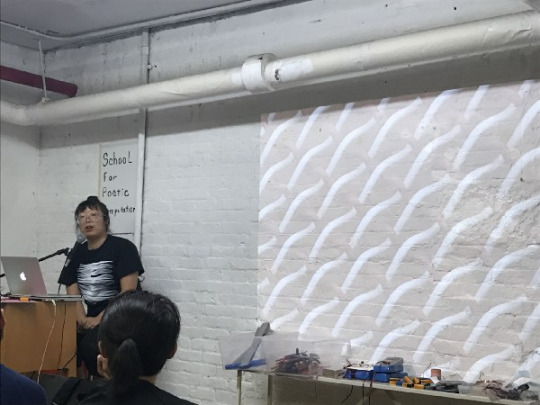
Pam is a computational designer working with textiles, who also has a background in jewelry design. Formerly a resident at Eyebeam Art and Technology Center, working on an open source jacquard loom, Pam’s work investigates the “tensions between craftsmanship, technology, and commerce.”
Taeyoon also lectured on the basics of hardware. He introduced the class to his handmade computer project and his work on demystifying computational technology.
“There is a sense of beauty in how computers are designed.” — Taeyoon Choi
The technical portion of his talk started with a discussion of voltage and current, resistance, and LEDs. He then quickly moved to circuit diagrams and translating drawings to life. He then threw the class into the deep end, having them soldering their own circuits and experiment with different kinds of switches.
vimeo
Day 4: Field trip to the MoMA Library
Thursday started with a field trip lead by Taeyoon to the MoMA Library, which houses an extensive collection of books, exhibition catalogs, correspondence, and other articles about individual artists and art collectives.
The students met Jennifer Tobias, who’s a librarian at MoMA, and learned about E.A.T (Experiments in Art and Technology), a collective established in the US in the 1960s to facilitate collaborations between artists and engineers. The group was set up by engineers Billy Klüver and Fred Waldhauer and the artists Robert Rauschenberg and Robert Whitman, who founded the group after the success of their event, “9 Evenings: Theater & Engineering.” The conversation lead to appreciation of artists and engineers like David Tudorwho’s practice influenced music, conceptual art as well as engineering.
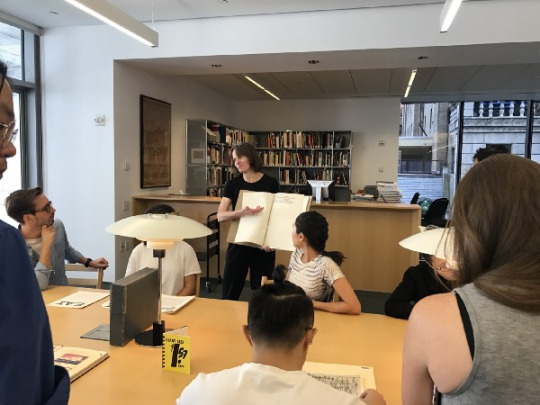
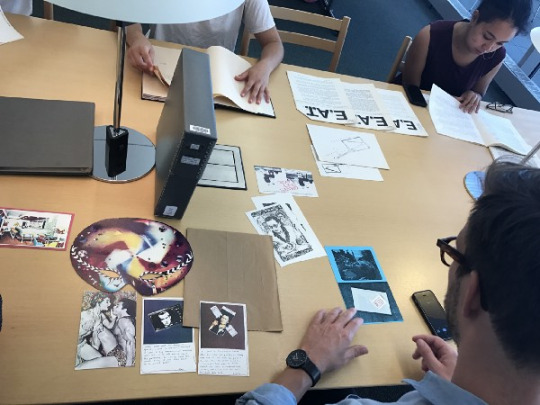
Students spent the morning reading over notes, letters, postcards, and speech transcripts from E.A.T members.
Day 4 cont’: Meet the Students!
The week ended with a coming out party for the fall 2017 class. In a rapid fire salon-style evening with alumni and community members, each student gave a four minute presentation on their work and their motivation for coming to SFPC. It was an intimate and welcoming audience excited to hear about what this semester’s SFPC is up to. Afterwards, students and attendees mingled and discussed art, media, and future collaborations.
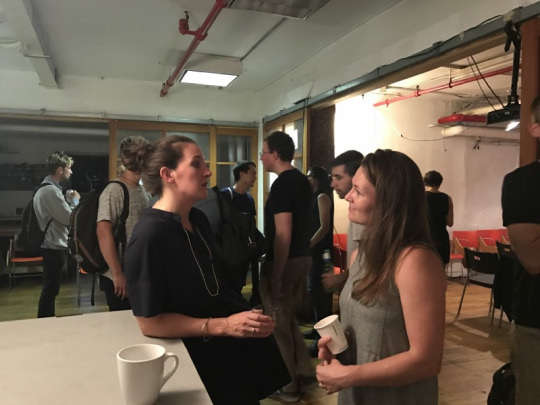
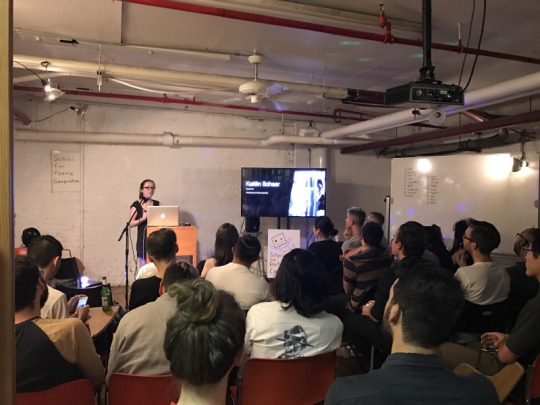
For their presentations, student shared their work and plans for SFPC:
Colin gave an overview of his work as a mechanical engineer and woodworker, including the process behind his pieces.
Kaitlin talked about her evolution as a photographer from traditional landscape photography to digital photo manipulation to VR.
Matt O. showed his projects that combined his love of music and technology.
Yumi gave an overview of her work as a motion graphics designer and told the group that when she read the SFPC motto, “more poetry, less demos” she knew it would be the right place for her.
Fernando talked about his game Panoramical, a game he made about navigating the US healthcare system, and his responsibility as an artist and maker in today’s political climate.
April shared her weird side projects.
Guillermo talked about his creative coding school in Chile, and his work as an electrical engineer and musician.
Heather talked about her company’s work in equality and sustainability, her interest in algorithmic biases, and her love of pair programming.
Niklas told the group about how he taught himself graphic design, ran his own agency, and traveled to Japan.
Qiao talked about her frustrations with teleconferencing with international colleagues, and her plans to build a real time translation app that would take into account the speaker’s mood and intention.
Matt J showed off his mesmerizing, math-based looping GIFs.
Stacy talked about her background in cognitive science, her love of the outdoors, and her hopes for SFPC.
Diego shared his 36 days of type challenge, his agency, and the complexity of running a restaurant.
Ying shared his love of photography and the powerful emotions a single image can evoke, and wondered how the same effect could be achieved through code.
Hyojin talked about her evolution from designer to artist and her interest in how identity is constructed.
Wei talked about his time at the New Inc. incubator and his artistic collaboration with his wife (together they form the creative duo He & Hu).
Ann shared her love of cyborgs and their relationship to the mixed race experience, and her interest in exploring discomfort as an artistic tool.
Amit closed the night by inviting the audience to choose one of three potential presentations. After taking a survey of the room, he shared a recent philosophical conundrum that’s been nagging at him: if you were to die right now and be given the choice to continue life but with no knowledge this choice had been presented, or to move on to a state of nothingness, which would you choose?
vimeo

3 notes
·
View notes
Text
The Role of Big Data in Precision Marketing: Algorist Global's Impactful Solutions

In the realm of modern digital marketing, the significance of Big Data cannot be overstated. As brands strive to connect with their target audiences in more meaningful ways, the utilisation of vast datasets has become a linchpin in crafting precision marketing strategies. Algorist Global, a forward-thinking digital marketing company, has not only recognized but harnessed the power of Big Data to offer impactful solutions that redefine the landscape of precision marketing.
The Foundation of Precision: Big Data Analytics
At the heart of Algorist Global's approach to precision marketing lies the utilisation of Big Data analytics. The company recognizes that buried within the vast amounts of data generated daily are invaluable insights waiting to be unearthed. By employing advanced analytics tools, Algorist Global transforms this raw data into actionable intelligence, providing brands with a comprehensive understanding of their audience's behaviours, preferences, and engagement patterns.
Targeting with Unparalleled Precision
Precision marketing is all about reaching the right audience with the right message at the right time, and Big Data is the catalyst that makes it possible. Algorist Global's Digital Intelligence Platform mines intricate details from diverse datasets, allowing marketers to target specific demographics with unparalleled accuracy. This precise targeting not only enhances the relevance of advertisements but also maximises the efficiency of marketing budgets by eliminating wasteful spending on broad, untargeted campaigns.
Real-time Insights for Agile Campaigns
In the fast-paced world of digital marketing, timing is everything. Algorist Global's reliance on Big Data ensures that marketers have access to real-time insights. This agility empowers brands to adapt their strategies on the fly, responding to emerging trends, changing consumer behaviours, and even external factors. The ability to make data-driven decisions in real time sets the stage for campaigns that are not only precise but also incredibly responsive to the dynamic digital landscape.
Personalization at Scale
One of the key challenges in precision marketing is delivering personalised experiences at scale. Algorist Global rises to this challenge by leveraging Big Data to create highly personalised campaigns. Through detailed customer segmentation and behavioural analysis, brands can tailor their messaging to resonate with individual consumers. This level of personalization fosters a deeper connection between brands and their audience, driving engagement and brand loyalty.
Optimising Customer Journeys
Understanding the customer journey is pivotal for effective marketing, and Big Data provides the roadmap. Algorist Global's approach involves analysing the entire customer journey, from awareness to conversion and beyond. By identifying touchpoints and analysing customer interactions at each stage, brands can optimise their marketing efforts to guide consumers seamlessly through the sales funnel.
Data-driven Decision Making for Long-term Success
Algorist Global's emphasis on Big Data isn't just about immediate gains; it's about laying the foundation for long-term success. The continuous analysis of data allows brands to make informed decisions that evolve with the market. It's not just about the current campaign but about building a reservoir of knowledge that informs future marketing strategies, ensuring sustained growth and relevance.
Conclusion: Algorist Global's Vision for Precision Marketing
In conclusion, Algorist Global's impactful solutions in precision marketing are intricately tied to its astute utilisation of Big Data. By harnessing the power of vast datasets, the company enables brands to unlock insights that redefine how they connect with their audiences. From real-time decision-making to personalised campaigns at scale, Algorist Global's approach to precision marketing is not just about the present—it's a forward-looking strategy that propels brands towards sustained success in the ever-evolving digital landscape.
#Digital Intelligence#brand advertisements#Digital Marketing Company#technology#digital marketing#marketing#artificial intelligence
1 note
·
View note
Photo

Abacus Calculating-Table by Gregor Reisch: Margarita Philosophica, 1503. The woodcut shows Arithmetica instructing an algorist and an abacist (inaccurately represented as Boethius and Pythagoras).
0 notes
Text
Gerar monstros (ou será arte?) com Inteligência Artificial para pensar o futuro para lá do sonho
Com a GANBreeder, podemos criar imagens surreais interagindo com Inteligência Artificial. Ao fazê-lo, refletimos sobre os temores desta tecnologia e o significado da arte. Ver mais em Bit2geek.com #Bit2geek.com #SAPO #IA #AI #GANBreeder #arte #InteligênciaArtificial #BeBots #LeonelMoura #criatividade #criar #artedigital #algorists
Artigo originalmente publicado a 10 de abril em versão curta no Sapo 24: Gerar monstros (ou será arte?) com Inteligência Artificial para pensar o futuro para lá do sonho.
Falar de Inteligência Artificial invoca sempre alguns medos e temores. Mas, e porque não usar esta tecnologia para criar algo de inquietante? Não no sentido social ou económico que geralmente lhe associamos, mas num sentido…
View On WordPress
0 notes
Video
youtube
Introduction post.
Η αλγοριθμική τέχνη γνωστή και ως η τέχνη που δημιουργείται από υπολογιστή είναι τέχνη κυρίως εικαστική, της οποίας το αποτέλεσμα είναι προϊόν αλγόριθμου.Οι αλγοριθμικοί καλλιτέχνες μερικές φορές ονομάζονται και “αλγοριθμιστές” (algorists).
Η αλγοριθμική τέχνη είναι ένα υποσύνολο της generative art και σχετίζεται ��ε την τέχνη των συστημάτων. Κάποιοι από τους τύπος της αλγοριθμικής τέχνης είναι:
Cellular automata: μπορούν να χρησιμοποιηθούν για την δημιουργία καλλιτεχνικών μοτίβων ή για την τροποποίηση εικόνων, όπως φωτογραφιών εφαρμόζοντας έναν μετασχηματισμό επανειλημμένα έως ότου να επιτευχθεί το επιθυμητό καλλιτεχνικό αποτέλεσμα.
Fractal art: αποτελείται από ποικιλίες fractal που δημιουργούνται από υπολογιστή με χρωματισμό που επιλέγεται από τον καλλιτέχνη. Στον δυτικό κόσμο δεν σχεδιάζονται ούτε ζωγραφίζονται στο χέρι, συνήθως δημιουργούνται με την βοήθεια ενός λογισμικού δημιουργίας fractal. Μια διαδικασία που αποτελείται από τρεις φάσεις: καθορισμός παραμέτρων κατάλληλου λογισμικού fractal, εκτέλεση του ενδεχομένως χρονοβόρου υπολογισμού και αξιολόγηση του προϊόντος.
Genetic ή evolutionary art: ο καλλιτέχνης χρησιμοποιεί γενετικούς αλγόριθμους για την ανάπτυξη εικόνων.
Όλα τα πρώτα γνωστά παραδείγματα αλγοριθμικής τέχνης που δημιουργήθηκαν από υπολογιστή δημιουργήθηκαν από τους Georg Nees, Frieder Nake, A Michael Noll, Manfred Mohr και Vera Molnár στις αρχές της δεκαετίας του 1960. Αυτά τα έργα τέχνης εκτελέστηκαν από έναν σχεδιαστή που ελέγχεται από έναν υπολογιστή, και ως εκ τούτου ήταν υπολογιστές αποκλειστικά για generative art και όχι γενικότερα για ψηφιακή τέχνη. Άρχισαν να αποτελούν υπολογιστές και για ψηφιακή τέχνη στα τέλη το 1980 με την δημιουργία των fractal.
Τέλος για να θεωρηθεί ένα έργο τέχνης αλγοριθμική τέχνη, η δημιουργία του πρέπει να περιλαμβάνει μια διαδικασία βασισμένη σε έναν αλγόριθμο που επινόησε ο καλλιτέχνης.
via https://www.hisour.com/algorithmic-art-12807/?fbclid=IwAR3GZ0SzmhPkZA6mkLHlit8cOY3cbGf1OWYpvfE4aB6KzdPNQDD98Yb_Uhw
1 note
·
View note
Text
New Wallet Rahakott Will Make the Cryptocurrency World More Accessible
On November 12, 2017, a new project, Rahakott, was launched. Rahakott is a crytocurrency wallet that allows anyone to send or receive digital currencies and to monitor their balance. The surge in demand for cryptocurrencies drives demand for solutions that are more convenient and simpler to implement.
Digital currencies do not exist in physical form and are not stored in a single place. All that actually exist are transaction records in a blockchain. Therefore, when Bitcoin or other cryptocurrencies are transferred, the ownership rights to a certain amount are simply rewritten to your wallet’s address. However, to take control of that currency, the private key for your wallet has to match the public address to which the currency has been allocated. If they match, a withdrawal happens at one wallet and a deposit at the other. And all of this is just a record in the blockchain.
“The market does not currently offer that many choices of suitable, easy to use wallets that would give both security and speed in processing transactions,” comments Akke Svenson, the wallet’s founder. “We have had the audacity to address all the existing issues with the Rahakott wallet.”
The key issue is registration. It is on this step that some users simply cannot make sense of the system and go on to look elsewhere. The Rahakott service offers simple registration without email or phone, with just a mnemonic phrase. Despite the simplicity of registration, the waller is well-protected from hacking by two-factor authentication. In addition, users that conduct business using cryptocurrency can set up subaccounts for their clients and generate requests for payment. Rahakott has functionality that allows batch generation of a large number of addresses. Miners have the ability to set a wallet address as to where they would like to receive their reward for mining.
The wallets are algoristic, meaning that a new address is generated for each transaction, which increases user anonymity. The existence of an API allows for the wallet’s functionality to be integrated into external web services and software.
“Rahakott went live on November 12,” says Akke Svenson. “We plan to keep perfecting the service’s functionality as we go. Our next step is to integrate currency exchanges, so that clients can choose the best exchange rates when converting to other cryptocurrencies and fiat currencies (P2P exchange). Our service serves to disrupt the status quo in the modern financial system, which is riddled with limitations, fees, and difficulties in processing transactions. We find ourselves at the starting point of a new, independent, and transparent financial future. And we’re building that world together!”
Project Team
Akke Svenson, Rahakott.io cryptocurrency wallet founder Entrepreneur, IT specialist, blockchain enthusiast. Graduated from the Royal Institute of Technology in Sweden and Stanford University in the US. He began his career at Ericsson, then worked on developing services for financial companies in Europe. For a few years, he served as CTO at a Silicon Valley fintech startup. After that, he returned to Sweden and founded his own company, specializing in IT consulting. He became interested in blockchain in 2013, believing that modern technology will help build new economic relationships in the world.
Maksim Shreyder, Rahakott.io cryptocurrency wallet cofounder IT expert. Graduated from the Moscow Institute of Physics and Technology and the University of London. He began his career as a programmer, developed projects in the e-commerce sector, and headed IT departments at Russian and English companies. In 2015 he became interested in cryptocurrencies and mining.
The post New Wallet Rahakott Will Make the Cryptocurrency World More Accessible appeared first on NEWSBTC.
from Cryptocracken WP http://ift.tt/2yQ4r6Y via IFTTT
0 notes